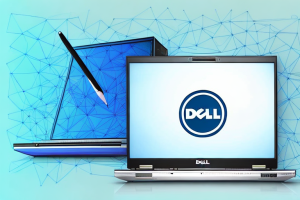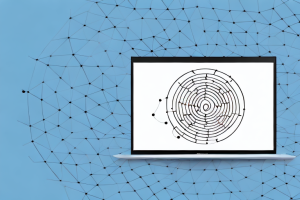How to fix a touchpad not working issue on a Dell XPS 13 9380
8 min read
A dell xps 13 9380 laptop with a highlighted touchpad
The touchpad on your Dell XPS 13 9380 can provide a convenient and efficient way to interact with your computer. However, like any other computer component, it can occasionally develop issues. In this article, we’ll walk you through the steps to fix a touchpad not working issue on a Dell XPS 13 9380. We’ll cover troubleshooting common touchpad issues, checking if your touchpad driver is up-to-date, uninstalling and reinstalling the touchpad driver, resetting the touchpad settings, fixing non-responsive touchpads, troubleshooting and fixing touchpad scrolling issues, the role of BIOS in fixing touchpad issues, updating your BIOS, performing regular maintenance checks for your touchpad, and disabling and enabling the touchpad. So, let’s get started!
Troubleshooting common touchpad issues on a Dell XPS 13 9380
Before we delve into more complex solutions, it’s important to troubleshoot common touchpad issues as they can often be fixed with simple steps. First, make sure that your touchpad is not disabled. Some Dell laptops come with a touchpad on/off button or a Fn key combination that can disable or enable the touchpad. Secondly, check if there is any physical damage to the touchpad such as scratches or cracks that may affect its functionality. Thirdly, clean your touchpad surface as dirt, dust, or oil buildup can interfere with the touchpad’s ability to track your finger movements accurately. If none of these steps help, move on to the next solution.
Another common issue with touchpads is that they may not respond to your finger movements or may respond erratically. In such cases, try adjusting the touchpad sensitivity settings in your laptop’s control panel. You can also try updating the touchpad driver software to the latest version as outdated drivers can cause touchpad issues.
If you are still experiencing touchpad issues, it may be a hardware problem. In such cases, you may need to replace the touchpad or seek professional help from a technician. It’s important to note that attempting to fix hardware issues on your own may cause further damage to your laptop and void any warranty that you may have.
How to check if your touchpad driver is up-to-date on a Dell XPS 13 9380
If your touchpad issues persist, the next step is to check if your touchpad driver is up-to-date. To do this, go to the Dell Support website and enter your Dell XPS 13 9380’s service tag or express service code. Then, click on the Drivers & Downloads section and select your operating system. Under the Input category, locate the touchpad driver and click on Download and install the latest version if it’s available. If your touchpad driver is already up-to-date, skip this step and move on to the next solution.
It’s important to note that updating your touchpad driver may not always solve the issue. If you’ve updated the driver and are still experiencing problems, try adjusting the touchpad settings in the Control Panel. You can adjust the sensitivity, scrolling speed, and other settings to see if that improves the performance of your touchpad.
If neither updating the driver nor adjusting the settings helps, it may be a hardware issue. In this case, it’s best to contact Dell Support for further assistance. They may need to repair or replace the touchpad to resolve the issue.
The importance of updating your touchpad driver on a Dell XPS 13 9380
Updating your touchpad driver can fix a wide range of touchpad issues, including non-responsive touchpads and touchpad scrolling issues. A new driver may also be necessary if you’ve recently performed a Windows update or upgraded your operating system. Additionally, a touchpad driver update can optimize your touchpad’s performance and features.
Another reason to update your touchpad driver is to ensure compatibility with new software or hardware. If you’ve recently installed a new program or device that interacts with your touchpad, it’s possible that your current driver may not be able to properly communicate with it. Updating your driver can help prevent any compatibility issues and ensure that your touchpad works seamlessly with all of your devices and software.
Finally, updating your touchpad driver can also improve your overall computer performance. Outdated drivers can cause your computer to run slower or even crash, so keeping them up to date is important for maintaining optimal performance. By updating your touchpad driver, you can ensure that your computer runs smoothly and efficiently, allowing you to get more done in less time.
How to uninstall and reinstall the touchpad driver on a Dell XPS 13 9380
If updating your touchpad driver doesn’t help, the next solution is to uninstall and reinstall it. To do this, right-click on the Start menu and select Device Manager. Expand the Mice and other pointing devices category and locate your touchpad device. Right-click on it and select Uninstall device. Then, restart your computer, and Windows will automatically reinstall the touchpad driver. Check if your touchpad is working correctly after the driver reinstallation.
It’s important to note that before uninstalling the touchpad driver, you should make sure that you have a backup mouse or touchpad available to use. This is because once you uninstall the driver, your touchpad will no longer work until the driver is reinstalled. If you don’t have a backup input device, you may not be able to navigate your computer to reinstall the driver. It’s also a good idea to download the latest touchpad driver from the Dell website before uninstalling the current driver, so that you can quickly reinstall it without an internet connection if needed.
A step-by-step guide to resetting your touchpad settings on a Dell XPS 13 9380
If you’re still having touchpad issues, the next solution is to reset the touchpad settings. To do this, go to the Windows Settings app by pressing the Windows key + I. Click on Devices > Touchpad. Then, click on the Reset button under the Reset your touchpad section. This action will restore all touchpad settings to their default values. Check if your touchpad is working correctly after resetting it.
It’s important to note that resetting your touchpad settings will also remove any customizations you may have made. If you had previously adjusted the sensitivity or scrolling speed of your touchpad, you will need to readjust these settings after the reset.
If resetting your touchpad settings does not solve the issue, you may need to update your touchpad driver. To do this, go to the Device Manager by pressing the Windows key + X and selecting Device Manager from the menu. Expand the Mice and other pointing devices category, right-click on your touchpad device, and select Update driver. Follow the on-screen instructions to complete the update.
Fixing a non-responsive touchpad on a Dell XPS 13 9380
If your touchpad is non-responsive, it could be due to a hardware issue. In this case, you may need to contact Dell Support for assistance. However, before doing so, try the following solutions. First, restart your computer as a simple reboot can resolve some touchpad issues. Next, disconnect any external devices that are connected to your Dell XPS 13 9380. Sometimes, a USB device or mouse can interfere with the touchpad’s functionality. Finally, try booting your computer in Safe Mode to see if the touchpad works correctly. If it works in Safe Mode, it means that a third-party software or driver is causing the issue, and you need to identify and uninstall it.
If none of the above solutions work, you can try updating your touchpad driver. Go to the Dell website and search for the latest touchpad driver for your Dell XPS 13 9380. Download and install the driver, and then restart your computer. This may resolve the touchpad issue.
If updating the touchpad driver does not work, you can try resetting your computer to its factory settings. This will erase all your data and installed programs, so make sure to back up your important files before proceeding. To reset your Dell XPS 13 9380, go to Settings > Update & Security > Recovery. Click on the “Get started” button under “Reset this PC” and follow the on-screen instructions. After the reset, check if the touchpad is working correctly.
How to troubleshoot and fix touchpad scrolling issues on a Dell XPS 13 9380
If you’re having issues with touchpad scrolling, try the following solutions. First, make sure that the Scrolling feature is enabled in the touchpad settings. To check this, go to the Windows Settings app > Devices > Touchpad > Additional settings. In the Mouse Properties window, click on the Device Settings tab and locate the scrolling option. Make sure it’s enabled. Next, check if there is any dirt or debris on the touchpad surface that could interfere with the scrolling movement. Finally, try updating your touchpad driver as an outdated driver could cause scrolling issues.
Another solution to try is to adjust the touchpad sensitivity. Sometimes, the touchpad may be too sensitive or not sensitive enough, which can affect scrolling. To adjust the sensitivity, go to the Windows Settings app > Devices > Touchpad > Additional settings. In the Mouse Properties window, click on the Device Settings tab and locate the touchpad sensitivity option. Adjust the sensitivity to your liking and test if scrolling works better.
If none of the above solutions work, it may be a hardware issue. In this case, you may need to contact Dell support or take your laptop to a professional for repair. It’s important to address touchpad scrolling issues as they can greatly affect your productivity and overall user experience.
The role of BIOS in fixing touchpad issues on a Dell XPS 13 9380
If you’ve tried all the solutions above and your touchpad issues persist, it may be time to update your BIOS. The BIOS (Basic Input/Output System) is a firmware that controls the hardware of your computer, including the touchpad. A BIOS update can fix many touchpad issues, including non-responsive touchpads and touchpad scrolling issues.
A comprehensive guide to updating your BIOS for fixing touchpad issues on a Dell XPS 13 9380
To update your BIOS, go to the Dell Support website and enter your Dell XPS 13 9380’s service tag or express service code. Click on the Drivers & Downloads section and select your operating system. Under the BIOS category, locate and download the latest version of the BIOS file. Then, copy the downloaded file to a USB drive. Restart your computer and press the F12 key repeatedly to enter the Boot Options menu. Select the USB drive from the list of boot devices and follow the on-screen instructions to install the BIOS update. After the update is complete, restart your computer, and check if your touchpad is working correctly.
The benefits of performing regular maintenance checks for your touchpad on a Dell XPS 13 9380
Regular maintenance checks can prevent touchpad issues before they occur, saving you time and hassle. Some maintenance tips include cleaning your touchpad surface with a soft cloth and avoiding using the touchpad with wet fingers. You can also use compressed air to blow dust and debris out of the touchpad area. Additionally, make sure to install and update an antivirus program to prevent malware that could affect your touchpad’s functionality.
How to disable and enable the touchpad on a Dell XPS 13 9380
If you want to temporarily disable your touchpad, you can do so by pressing the Fn key and the F7 key simultaneously. To enable it, repeat the same action.
We hope that this article has helped you fix your touchpad issues on your Dell XPS 13 9380. If your touchpad still doesn’t work after trying all the solutions, contact Dell Support for further assistance.


